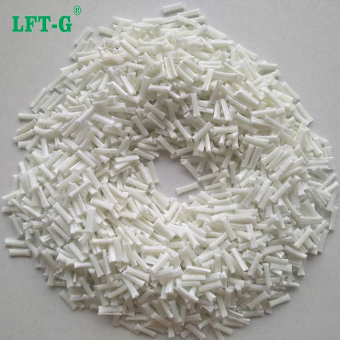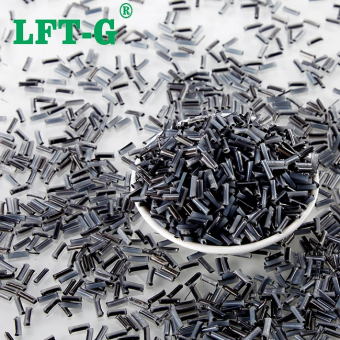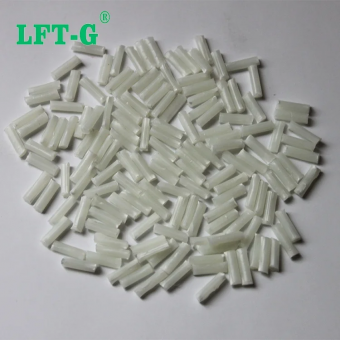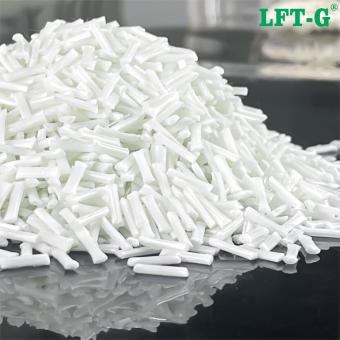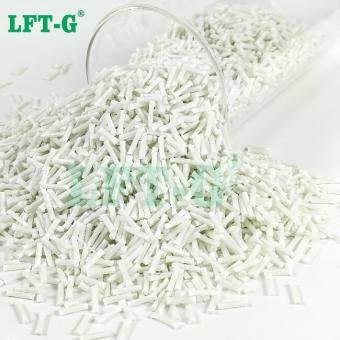-
Xiamen LFT Nylon Polyamide 6 excellent heat resistant properties Long glass fiber Filled PelletsWhat is Polyamide? Polyamide (PA) Polyamide, which is also known by the trade name, Nylon, has excellent heat resistant properties, especially when combined with additives and filler materials. In addition to this, Nylon is very resistant to abrasion. Xiamen LFT offers a wide range of temperature-resistant nylons with many different filler materials. If you are not sure which PA material is suitable for you, please tell us your needs and our team will provide you with technical support free of charge. What is Polyamide 6? Nylon 6 or PA 6 Has a semi-crystalline structure and is used for nonwoven fabrics Ductility and Abrasion resistance What Are the Advantages of Nylon 6? The main advantages of nylon 6 are its stiffness and resistance to abrasion. Moreover, this material has excellent impact strength, wear resistance, and electrical insulating properties. Nylon 6 is a highly elastic and fatigue-resistant material, meaning it will return to its original proportions after being distorted by tension. This polyamide is non-toxic and can be combined with glass or carbon fibers to increase performance. The absorption capacity of the material grows in direct proportion to the quantity of moisture it absorbs. The high affinity of nylon 6 for some dyestuffs allows for more dyeing diversity, with the potential for brighter, deeper patterns. Can Nylon 6 Be Used in Plastic Injection Molding? Yes, Nylon 6 is a suitable material for injection molding. The resulting molded nylon parts possess great strength, as well as chemical and temperature resistance. When molding nylon 6, the material is sometimes injected with a specified amount of glass fibers (usually between 20% and 60%) to boost its tensile strength. Glass fibers improve stiffness. Moreover, since UV radiation can be harmful to nylon, a UV stabilizer is frequently added to the material before injection molding to decrease the possible degradation of the item with time. Is Nylon 6 a Copolymer? No, nylon 6 is not a copolymer. The clue is in the name “nylon 6” in which the 6 represents the single repeating monomer which has 6 carbon atoms. Nylon 6 is made through the polymerization of a monomer named caprolactam. Nylon 6 is not to be confused with nylon 6,6 which is made of two repeating monomers hexamethylenediamine and adipic acid; this makes it a copolymer. Two other nylons are also copolymers; they are nylon 6,12 and nylon 4,6. Why filling Long Glass Fiber into Polyamide 6? Long glass fiber reinforced composites can solve your problems when other methods of reinforced plastics do not provide the performance you need or if you want to replace metal with plastic. Long glass fiber reinforced composites can cost-effectively reduce the cost of goods and effectively improve the mechanical properties of engineering polymer .Long fibers can be uniformly distributed inside the product to form a network skeleton, thus improving the mechanical properties of the material product. LFT is the product name for a family of long fiber reinforced thermoplastic materials for Injection Molding, Compression Molding and Extrusion applications. These materials differ from standard thermoplastic compounds in the length of the fiberglass in the pellets. Retention of fiber length in the finished part is key to the performance of LFT. The fiberglass is continuous within the pellet and offers incredible properties and performance when molded correctly. What is the application of PA6-LGF? Other PA Plastic you may interested: PA66-LGF PA12-LGF About Xiamen LFT
- LFT Long fibre glass reinforced thermoplastic resin
- Polyamide 6 PA plastic
- High strength for car parts auto
- raw materials made in China good price
- high-performing polymer
- washing machine drum parts good appearance
Tags :
-
Xiamen LFT Polyamide 12 Long Carbon Fiber Composite Nylon Pellets PolymerLFT PA12 Long Carbon Fiber Composite Data Sheet and Technical Guidance
- Long Carbon Fiber Composite high strength
- LFT PA12 Long Carbon Fiber for car parts
- Nylon 12 Pellets Polymer engineering plastic
- PA12 Granules thermoplastic resin instead metal
- Pa12 Pellets Polyamide lightweight
- PA12 Long Carbon Fiber Composite
Tags :
-
Xiamen LFT Nylon Polyamide 6 excellent heat resistant properties Long glass fiber Filled PelletsWhat is Polyamide? Polyamide (PA) Polyamide, which is also known by the trade name, Nylon, has excellent heat resistant properties, especially when combined with additives and filler materials. In addition to this, Nylon is very resistant to abrasion. Xiamen LFT offers a wide range of temperature-resistant nylons with many different filler materials. If you are not sure which PA material is suitable for you, please tell us your needs and our team will provide you with technical support free of charge. What is Polyamide 6? Nylon 6 or PA 6 Has a semi-crystalline structure and is used for nonwoven fabrics Ductility and Abrasion resistance What Are the Advantages of Nylon 6? The main advantages of nylon 6 are its stiffness and resistance to abrasion. Moreover, this material has excellent impact strength, wear resistance, and electrical insulating properties. Nylon 6 is a highly elastic and fatigue-resistant material, meaning it will return to its original proportions after being distorted by tension. This polyamide is non-toxic and can be combined with glass or carbon fibers to increase performance. The absorption capacity of the material grows in direct proportion to the quantity of moisture it absorbs. The high affinity of nylon 6 for some dyestuffs allows for more dyeing diversity, with the potential for brighter, deeper patterns. Can Nylon 6 Be Used in Plastic Injection Molding? Yes, Nylon 6 is a suitable material for injection molding. The resulting molded nylon parts possess great strength, as well as chemical and temperature resistance. When molding nylon 6, the material is sometimes injected with a specified amount of glass fibers (usually between 20% and 60%) to boost its tensile strength. Glass fibers improve stiffness. Moreover, since UV radiation can be harmful to nylon, a UV stabilizer is frequently added to the material before injection molding to decrease the possible degradation of the item with time. Is Nylon 6 a Copolymer? No, nylon 6 is not a copolymer. The clue is in the name “nylon 6” in which the 6 represents the single repeating monomer which has 6 carbon atoms. Nylon 6 is made through the polymerization of a monomer named caprolactam. Nylon 6 is not to be confused with nylon 6,6 which is made of two repeating monomers hexamethylenediamine and adipic acid; this makes it a copolymer. Two other nylons are also copolymers; they are nylon 6,12 and nylon 4,6. Why filling Long Glass Fiber into Polyamide 6? Long glass fiber reinforced composites can solve your problems when other methods of reinforced plastics do not provide the performance you need or if you want to replace metal with plastic. Long glass fiber reinforced composites can cost-effectively reduce the cost of goods and effectively improve the mechanical properties of engineering polymer .Long fibers can be uniformly distributed inside the product to form a network skeleton, thus improving the mechanical properties of the material product. LFT is the product name for a family of long fiber reinforced thermoplastic materials for Injection Molding, Compression Molding and Extrusion applications. These materials differ from standard thermoplastic compounds in the length of the fiberglass in the pellets. Retention of fiber length in the finished part is key to the performance of LFT. The fiberglass is continuous within the pellet and offers incredible properties and performance when molded correctly. What is the application of PA6-LGF? Other PA Plastic you may interested: PA66-LGF PA12-LGF About Xiamen LFTview more
-
LFT-G® Polyamide 66 Long Carbon Fiber Filled Compounds Injection molding pelletsWhat is LFT Materials? LFT long fiber reinforced thermoplastic engineering materials,compared to ordinary short fiber reinforced thermoplastic materials (fiber length is less than 1-2 mm), the LFT process produces thermoplastic engineering material's fibers in lengths of 5-25 mm. The long fibers are impregnated with the resin through a special mold system to obtain long strips that are fully impregnated with the resin ,and then cut to the length as required. The most used base resin is PP, by PA6, PA66, PPA,PA12,MXD6,PBT, PET,TPU,PPS, LCP,PEEK, etc. Conventional fibers include glass fiber, carbon fiber,special fibers include basalt fiber and quartz fiber, etc. Depending on the end use, the finished products can be used for injection molding,extrusion, molding, etc., or directly used for plastic instead of steel and thermoset products. Long carbon fiber reinforced composites can solve your problems when other methods of reinforced plastics do not provide the performance you need or if you want to replace metal with plastic. Long carbon fiber reinforced composites can cost-effectively reduce the cost of goods and effectively improve the mechanical properties of engineering polymer. Long fibers can be uniformly distributed inside the product to form a network skeleton, thus improving the mechanical properties of the material product. What is Polyamide 66 Long Carbon Fiber Reinforcement? Nylon 6,6, also written as nylon 6-6, nylon 66, or nylon 6/6, is a more crystalline version of nylon 6. It is also referred to as polyamide 66 or PA 66. It has improved mechanical properties due to its more ordered molecular structure. Nylon 66 for machining has improved temperature resistance and lower rates of water absorption when compared to standard nylon 6. The advantages of nylon 6,6 are that the yield strength is higher than nylon 6 and nylon 610. It has high strength, toughness, rigidity, and low coefficient of friction in a wide temperature range. In addition, it is oil resistant and resistant to chemical reagents and solvents. However, PA66 has strong hygroscopicity and poor dimensional stability, which limits its application. In order to obtain nylon 66 engineering material with higher strength, it should be modified by carbon fiber reinforcement. The mechanical properties of long carbon fiber reinforced nylon 66 (LCFR-PA66) are obviously better than those of short carbon fiber reinforced nylon 66 (SCFR-PA66), and the molding processing performance is also better. It can be molded by various molding methods such as injection molding and compression molding, and complex components can also be formed. Therefore, long carbon fiber reinforced nylon 66 can be widely used in building materials, aerospace, electronic devices, furniture and other fields, especially in the automotive industry application market. The production process of long carbon fiber reinforced nylon 66 is different from that of short carbon fiber reinforced nylon 66. The short carbon fiber reinforced nylon 66 particle is chopped under the friction and shearing of screw and barrel, and the short carbon fiber reinforced nylon 66 particle is obtained with the length of carbon fiber monofilament about 0.5mm. The length of some carbon fiber monofilament in the final product is lower than the critical length of reinforcement, and the carbon fiber is easy to be extracted from the nylon 66 matrix when the product is stressed. The strength of carbon fiber is not fully utilized, and the mechanical properties of the product are not high. Long carbon fiber reinforced nylon 66 has better reinforcement effect and dimensional stability, and the rigidity, tensile, bending, impact resistance and fatigue resistance of the manufactured products are better, and the service life is longer. Q & A Q: Does long glass fiber and long carbon fiber injection have special requirements for injection molding machines and molds? A: There are certainly requirements. especially from the product design structure, as well as the injection molding machine screw nozzle and mold structure injection molding process must consider the requirements of long fiber. Q. The product is easy to brittle, so changing to use long fiber reinforced thermoplastic materials can solve this problem? A: The overall mechanical properties must be improved. The characteristics of long glass fiber and long carbon fiber are the advantages in mechanical properties. It has 1-3 times higher (toughness) than short fiber , and the tensile strength(strength and rigidity) is increased by 0.5-1 times. Q. How to choose the reinforcement method and length of the material when using long fiber reinforced thermoplastic material? A: The selection of materials depend on the requirements of the products. It is necessary to assess how much the content is enhanced and how muc...
- Reinforced thermoplastic resin composites
- Nylon PA 6.6 high strength plastic
- China manufacturer engineering plastic
- CF filament enhanced materials
- long cut fiber instead metal and steel
- high mechanical properties
Tags :
-
Xiamen LFT Polyamide 12 Filled Long Glass Fiber Compounds China manufacturerProduct Name: Polyamide12 long glass fiber composite,Nylon 12 composite Certificated: SGS, 16949 system certificated,MSDS,and so on.
- LFT PA12 LGF long glass fiber virgin grade
- Nylon Fill Long Glass Fiber polyamide 12 high strength
- Nylon 12 Plastic Price high rigidity
- Nylon Composite thermoplastic resin
- Nylon 12 LGF20 instead metal and steel
- Polyamide12 with fiber glass low warpage
Tags :
-
Xiamen LFT long glass fiber reinforced PP Polypropylene materials injectionglass reinforced PP Polypropylene materials polymer long glass fiber 30% injection for car parts,washing machine parts.
- Compound plastic materials PP resin
- Polypropylene with long glass fiber
- pp filling glass fiber reinforced thermoplastic
- High strength modified material
- pp lgf lft PP GF30 high rigidity
- long glass fiber reinforced polypropylene
Tags :
-
Xiamen LFT long glass fiber reinforced PP Polypropylene materials injectionglass reinforced PP Polypropylene materials polymer long glass fiber 30% injection for car parts,washing machine parts.view more
-
Xiamen LFT Thermoplastic Polyurethane resin filled long glass fiber engineering plastics high strengthTPU introduction Thermoplastic polyurethane (TPU) elastomers are linear polymers formed by the copolymerization of hard and soft chain segments, which have physical properties such as tensile, abrasion and heat resistance, and elasticity similar to rubber. Thanks to the excellent product performance, the application fields of TPU are expanding, including daily consumer goods, construction, medical, military, automotive, agriculture and many other fields. New products and applications are also emerging, such as large-diameter hoses (shale gas extraction), charging cables for new energy vehicles, foamed TPU (ETPU) sports shoes midsoles prepared by supercritical foaming process, invisible braces, etc. Fiber reinforced modified TPU composites TPU has good impact resistance, but in some applications, high modulus of elasticity and very hard material is required. Glass fiber reinforced modification is a common technical means to improve the elastic modulus of the material. Through modification, thermoplastic composites with many advantages such as high elastic modulus, good insulation, heat resistance, good elastic recovery, good corrosion resistance, impact resistance, low coefficient of expansion and dimensional stability can be obtained. Long glass fiber VS Short glass fiber Compared with the short fiber, long fiber has more excellent performance in mechanical properties. It is more suitable for large products and structural parts. It has 1-3 times higher toughness than short fiber, and the tensile strength is increased by 0.5-1 times. Thermoplastics VS Thermosets Thermosets: when heated for the first time, they can soften and flow, and when heated to a certain temperature, they produce a chemical reaction a cross-chain curing and become hard, this change is irreversible, after that, when heated again, they can no longer become soft and flow. Thermoplastic: thermoplastic resin is the main component, and various additives are added to form a plastic. Under certain temperature conditions, plastic can be softened or melted into any shape, and the shape remains unchanged after cooling; this state can be repeated many times and always has plasticity, and this repeated is only a physical change. Advantages Thermosets: Thermoset plastics retain their strength and shape even when heated. This makes thermoset plastics ideal for producing permanent parts and large, strong shapes. In addition, these parts have excellent strength properties (despite their fragility) and do not lose significant strength when exposed to higher operating temperatures. Thermoplastics: Thermoplastics are the most widely used plastics and typically have high chemical and thermal resistance, as well as a high strength structure that is not easily deformed. It is made of thermoplastic resin as the main component with various additives. Thermoplastic products have excellent electrical insulation, with very low dielectric constant and dielectric loss, suitable for high Frequency and high voltage insulation materials. TPU-LGF applications TDS for TPU-LGF Products details Number Length Colour Sample Price MOQ Package Delivery time TPU-NA-LGF30 12mm (can be customized) Natural colour (can be customized) Available Need to be confirmed 25kg 25kg/bag 7-15 days after shipment About us Company Xiamen LFT composite plastic Co., Ltd. is a brand-name company that focuses on LFT&LFRT. Long Glass Fiber Series (LGF) & Long Carbon Fiber Series (LCF). The company's thermoplastic LFT can be used for LFT-G injection molding and extrusion, and can also be used for LFT-D molding. It can be produced according to customer requirements: 5~25mm in length. The company's long-fiber continuous infiltration reinforced thermoplastics have passed ISO9001 &16949 system certification, and the products have obtained lots of national trademarks and patents.
- Low warpage electronic appliance
- tpu lgf30 for toe cap enhanced
- self owing tpu pellets instead metal
- tpu different resin lgf reinforced materials
- high strength and high toughness reinforced tpu pellets
- self owing tpu pellets polymer
Tags :
-
Xiamen LFT Thermoplastic Polyurethane resin filled long glass fiber engineering plastics high strengthTPU introduction Thermoplastic polyurethane (TPU) elastomers are linear polymers formed by the copolymerization of hard and soft chain segments, which have physical properties such as tensile, abrasion and heat resistance, and elasticity similar to rubber. Thanks to the excellent product performance, the application fields of TPU are expanding, including daily consumer goods, construction, medical, military, automotive, agriculture and many other fields. New products and applications are also emerging, such as large-diameter hoses (shale gas extraction), charging cables for new energy vehicles, foamed TPU (ETPU) sports shoes midsoles prepared by supercritical foaming process, invisible braces, etc. Fiber reinforced modified TPU composites TPU has good impact resistance, but in some applications, high modulus of elasticity and very hard material is required. Glass fiber reinforced modification is a common technical means to improve the elastic modulus of the material. Through modification, thermoplastic composites with many advantages such as high elastic modulus, good insulation, heat resistance, good elastic recovery, good corrosion resistance, impact resistance, low coefficient of expansion and dimensional stability can be obtained. Long glass fiber VS Short glass fiber Compared with the short fiber, long fiber has more excellent performance in mechanical properties. It is more suitable for large products and structural parts. It has 1-3 times higher toughness than short fiber, and the tensile strength is increased by 0.5-1 times. Thermoplastics VS Thermosets Thermosets: when heated for the first time, they can soften and flow, and when heated to a certain temperature, they produce a chemical reaction a cross-chain curing and become hard, this change is irreversible, after that, when heated again, they can no longer become soft and flow. Thermoplastic: thermoplastic resin is the main component, and various additives are added to form a plastic. Under certain temperature conditions, plastic can be softened or melted into any shape, and the shape remains unchanged after cooling; this state can be repeated many times and always has plasticity, and this repeated is only a physical change. Advantages Thermosets: Thermoset plastics retain their strength and shape even when heated. This makes thermoset plastics ideal for producing permanent parts and large, strong shapes. In addition, these parts have excellent strength properties (despite their fragility) and do not lose significant strength when exposed to higher operating temperatures. Thermoplastics: Thermoplastics are the most widely used plastics and typically have high chemical and thermal resistance, as well as a high strength structure that is not easily deformed. It is made of thermoplastic resin as the main component with various additives. Thermoplastic products have excellent electrical insulation, with very low dielectric constant and dielectric loss, suitable for high Frequency and high voltage insulation materials. TPU-LGF applications TDS for TPU-LGF Products details Number Length Colour Sample Price MOQ Package Delivery time TPU-NA-LGF30 12mm (can be customized) Natural colour (can be customized) Available Need to be confirmed 25kg 25kg/bag 7-15 days after shipment About us Company Xiamen LFT composite plastic Co., Ltd. is a brand-name company that focuses on LFT&LFRT. Long Glass Fiber Series (LGF) & Long Carbon Fiber Series (LCF). The company's thermoplastic LFT can be used for LFT-G injection molding and extrusion, and can also be used for LFT-D molding. It can be produced according to customer requirements: 5~25mm in length. The company's long-fiber continuous infiltration reinforced thermoplastics have passed ISO9001 &16949 system certification, and the products have obtained lots of national trademarks and patents.view more
-
LFT Polyamide 6 High Performance Filled Long Glass Fiber ReinforcementThe main benefits of using polyamide are its low cost combined with its desirable mechanical and chemical properties.
- Nylon 6 PA6 modified resin composites
- Injection mold plastic reinforced with filler
- engineering use automotive parts
- Long fiber glass fiberglass carbon fiber add
- High strength and toughness low warping
- China manufacturer good price
Tags :
-
LFT Polyamide 12 high performance long glass fiber reinforcementPA 12 GF30 is a type of engineering plastic that consists of polyamide 12 (PA 12) compounds reinforced with 30% glass fibers.
- High strength polyamide 12 composites
- Lightweight glass fiber PA12
- Durable PA12 reinforced with glass fibers
- PA12 GF for automotive applications
- Thermoplastic composite materials PA12 GF
- Injection molding PA12 glass fiber
Tags :

 e-mail
e-mail English
English français
français Deutsch
Deutsch русский
русский italiano
italiano español
español português
português العربية
العربية 日本語
日本語 한국의
한국의 中文
中文












